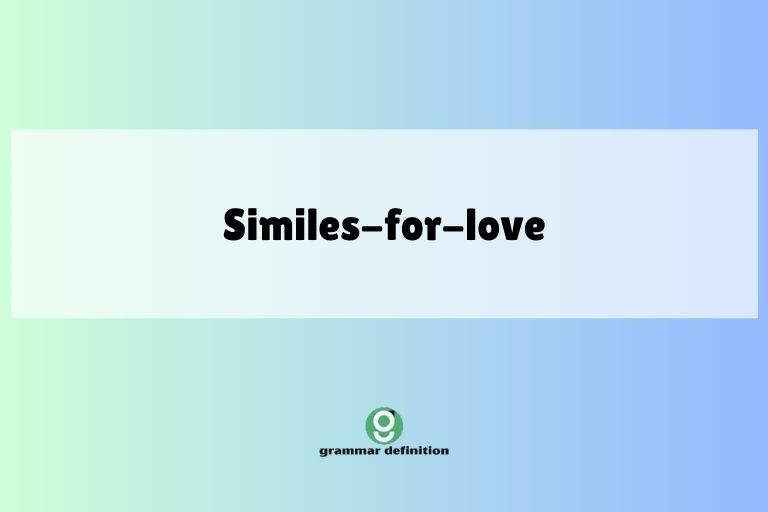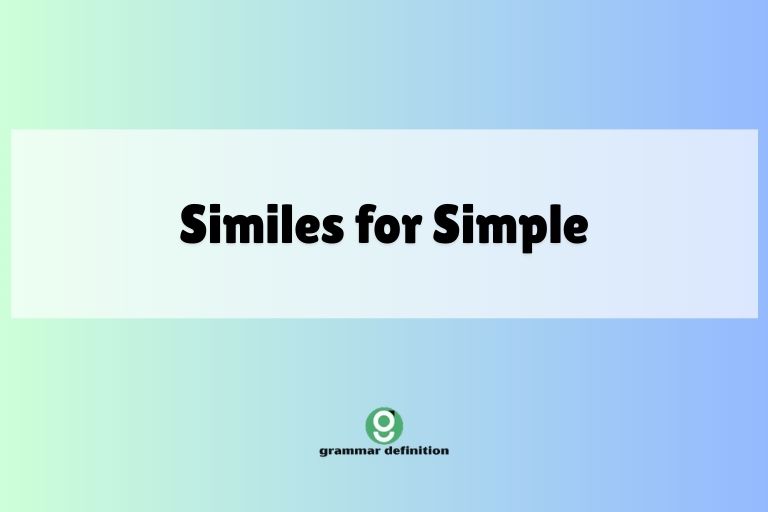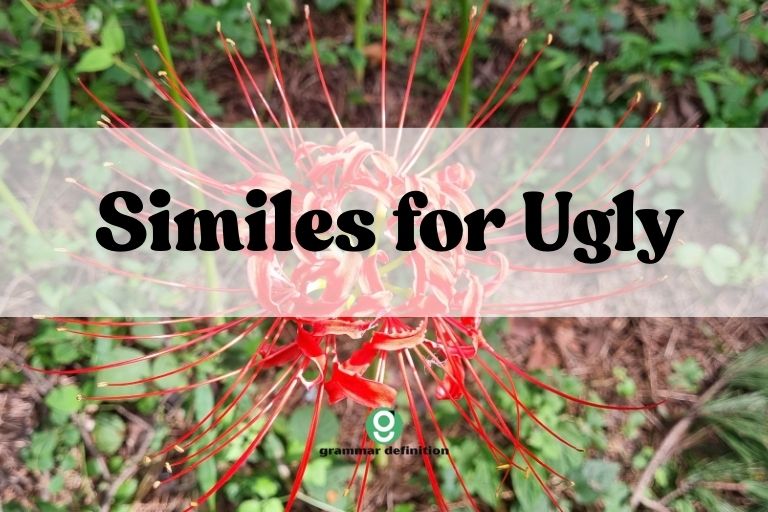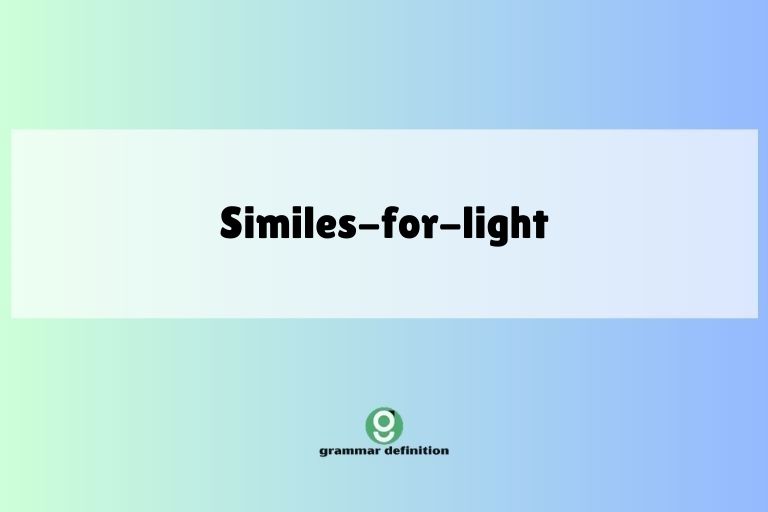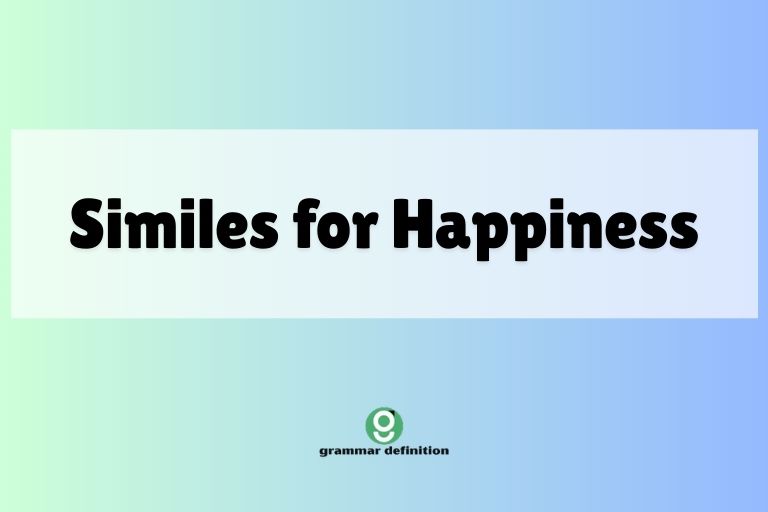Similes For Good: Mastering Comparisons in English
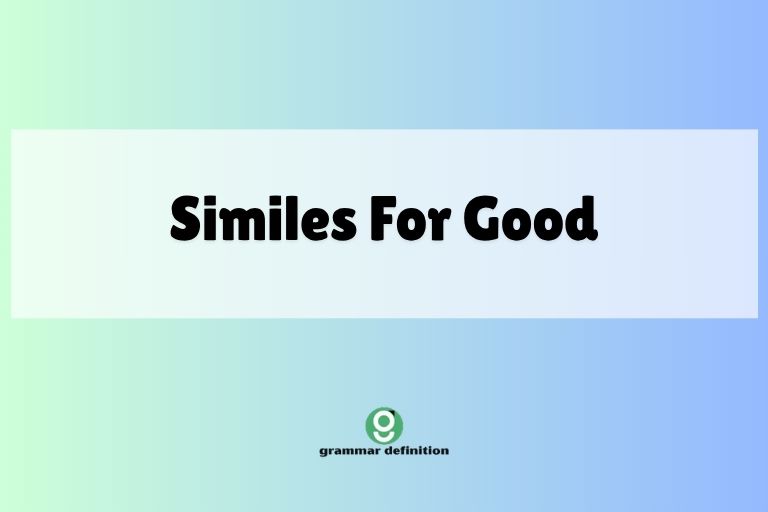
Similes are powerful tools in the English language, allowing us to create vivid imagery and make our writing and speech more engaging. Understanding how to use similes effectively is crucial for clear and impactful communication.
This article provides a comprehensive guide to similes for describing positive qualities, actions, and states, enhancing your ability to express yourself with precision and flair. Whether you’re a student, writer, or simply looking to improve your communication skills, this guide will equip you with the knowledge and practice needed to master the art of crafting effective similes.
This article explores the definition, structure, types, and usage of similes for describing good qualities. It provides numerous examples, usage rules, common mistakes, and practice exercises to ensure a thorough understanding of the topic.
By the end of this article, you’ll be able to confidently use similes to add depth and color to your descriptions, making your communication more compelling and memorable.
Table of Contents
- Definition of a Simile
- Structural Breakdown of a Simile
- Types of Similes
- Examples of Similes For Good
- Usage Rules for Similes
- Common Mistakes with Similes
- Practice Exercises
- Advanced Topics
- Frequently Asked Questions (FAQ)
- Conclusion
Definition of a Simile
A simile is a figure of speech that compares two unlike things using the words “like” or “as.” The purpose of a simile is to create a vivid or imaginative comparison that helps the reader or listener understand the subject more clearly. Unlike a metaphor, which directly equates two things, a simile acknowledges that the two things being compared are distinct but share a common characteristic.
Similes are often used to add descriptive detail, evoke emotions, or create a memorable image in the reader’s mind. They are a fundamental tool in creative writing, poetry, and everyday conversation.
Understanding how to construct and use similes effectively can significantly enhance your communication skills.
In essence, a simile functions as a bridge, connecting something familiar to something less familiar, thereby illuminating its qualities or characteristics. This makes complex ideas more accessible and engaging.
Structural Breakdown of a Simile
The basic structure of a simile consists of three main components: the subject, the linking word (either “like” or “as”), and the object of comparison. The subject is the thing being described, and the object of comparison is the thing it is being compared to. The linking word establishes the comparison between the two.
The structure can be represented as follows:
Subject + Linking Word (like/as) + Object of Comparison
For example:
Her smile was as bright as the sun.
In this example:
- Subject: Her smile
- Linking Word: as
- Object of Comparison: the sun
The effectiveness of a simile depends on the strength and relevance of the comparison. A good simile should create a clear and meaningful connection between the subject and the object of comparison, enhancing the reader’s understanding and appreciation of the subject.
Types of Similes
While all similes share the same basic structure, they can be categorized based on the type of comparison they make and the effect they create. Here are a few common types of similes:
Descriptive Similes
Descriptive similes focus on highlighting a particular characteristic or quality of the subject. They aim to provide a more vivid and detailed description.
Figurative Similes
Figurative similes use more imaginative and abstract comparisons, often creating a more evocative and emotional effect. These types of similes aren’t as literal as descriptive similes and may require the reader to think more deeply about the connection between the subject and the object of comparison.
Humorous Similes
Humorous similes are used to create a funny or ironic effect. They often involve unexpected or absurd comparisons, making the description more entertaining.
Examples of Similes For Good
Similes can be used to describe a wide range of positive qualities, actions, and states. Here are some examples organized by category:
Describing Positive Qualities
When describing positive qualities, similes can help to emphasize the strength, beauty, or value of a person, object, or idea. The following table provides examples of similes used to describe positive qualities.
| Quality | Simile | Explanation |
|---|---|---|
| Kindness | As kind as an angel | Emphasizes exceptional kindness and compassion. |
| Courage | As brave as a lion | Highlights fearlessness and bravery. |
| Intelligence | As smart as a whip | Suggests quick and sharp intelligence. |
| Honesty | As honest as the day is long | Implies unwavering honesty and integrity. |
| Patience | As patient as a saint | Highlights remarkable patience and tolerance. |
| Beauty | As beautiful as a sunrise | Compares beauty to a natural, awe-inspiring phenomenon. |
| Grace | As graceful as a swan | Illustrates elegance and fluidity in movement. |
| Strength | As strong as an ox | Emphasizes immense physical strength. |
| Wisdom | As wise as an owl | Suggests deep understanding and knowledge. |
| Generosity | As generous as a king | Highlights exceptional generosity and willingness to share. |
| Loyalty | As loyal as a dog | Implies unwavering faithfulness and devotion. |
| Humility | As humble as a lamb | Suggests meekness and lack of arrogance. |
| Optimism | As optimistic as a child | Highlights a hopeful and positive outlook on life. |
| Resilience | As resilient as a rubber band | Implies the ability to bounce back from adversity. |
| Clarity | As clear as crystal | Suggests transparency and lack of ambiguity. |
| Warmth | As warm as sunshine | Highlights a friendly and welcoming demeanor. |
| Peace | As peaceful as a sleeping baby | Suggests tranquility and serenity. |
| Confidence | As confident as a CEO | Implies strong self-assurance and belief in one’s abilities. |
| Efficiency | As efficient as a machine | Highlights productivity and effectiveness. |
| Creativity | As creative as an artist | Suggests imaginative and innovative thinking. |
| Dedication | As dedicated as a monk | Implies unwavering commitment and focus. |
| Focus | As focused as a laser beam | Highlights intense concentration and attention to detail. |
| Purity | As pure as snow | Suggests innocence and lack of corruption. |
| Sincerity | As sincere as a heartfelt letter | Implies genuineness and honesty. |
| Tact | As tactful as a diplomat | Highlights sensitivity and skill in dealing with delicate situations. |
Describing Positive Actions
Similes can also be used to describe positive actions, emphasizing their effectiveness, impact, or beauty. The following table provides examples of similes used to describe positive actions.
| Action | Simile | Explanation |
|---|---|---|
| Helping | Helped like a guardian angel | Emphasizes the protective and supportive nature of the help. |
| Leading | Led like a guiding star | Highlights the inspirational and directional quality of the leadership. |
| Teaching | Taught like a wise mentor | Suggests deep knowledge and effective guidance. |
| Healing | Healed like a magic touch | Implies a swift and effective restoration to health. |
| Inspiring | Inspired like a muse | Highlights the ability to ignite creativity and motivation. |
| Protecting | Protected like a fortress | Emphasizes the strength and security of the protection. |
| Nurturing | Nurtured like a tender gardener | Suggests careful and loving care. |
| Creating | Created like a master craftsman | Highlights the skill and artistry involved in the creation. |
| Solving | Solved like a puzzle master | Implies cleverness and expertise in finding solutions. |
| Innovating | Innovated like a visionary inventor | Highlights originality and forward-thinking. |
| Communicating | Communicated like a skilled orator | Suggests eloquence and persuasiveness. |
| Negotiating | Negotiated like a seasoned diplomat | Implies tact and expertise in reaching agreements. |
| Organizing | Organized like a meticulous librarian | Highlights attention to detail and efficiency. |
| Planning | Planned like a strategic general | Suggests foresight and careful preparation. |
| Executing | Executed like a well-oiled machine | Implies precision and efficiency. |
| Performing | Performed like a seasoned artist | Highlights skill and experience. |
| Singing | Sang like a nightingale | Emphasizes the beauty and sweetness of the singing. |
| Dancing | Danced like a flowing river | Illustrates grace and fluidity in movement. |
| Writing | Wrote like a gifted author | Highlights talent and skill in writing. |
| Speaking | Spoke like a persuasive advocate | Suggests eloquence and the ability to convince others. |
| Listening | Listened like an empathetic friend | Implies attentiveness and understanding. |
| Observing | Observed like a keen detective | Highlights attentiveness to detail and insight. |
| Adapting | Adapted like a chameleon | Suggests flexibility and the ability to adjust to new situations. |
| Persevering | Persevered like a tireless marathon runner | Emphasizes determination and endurance. |
| Contributing | Contributed like a valuable team player | Highlights the importance and impact of the contribution. |
Describing Positive States
Similes can also be used to describe positive states of being, such as happiness, peace, or contentment. The following table provides examples of similes used to describe positive states.
| State | Simile | Explanation |
|---|---|---|
| Happiness | As happy as a lark | Emphasizes joy and cheerfulness. |
| Peace | As peaceful as a still lake | Highlights tranquility and serenity. |
| Contentment | As content as a cat purring | Suggests satisfaction and comfort. |
| Freedom | As free as a bird | Implies liberation and lack of constraint. |
| Love | As loving as a mother’s embrace | Emphasizes warmth and affection. |
| Hope | As hopeful as a sunrise | Highlights optimism and the promise of a new beginning. |
| Joy | As joyful as a child’s laughter | Emphasizes pure and unadulterated happiness. |
| Comfort | As comfortable as a warm blanket | Suggests coziness and security. |
| Serenity | As serene as a mountain vista | Highlights calmness and tranquility. |
| Bliss | As blissful as a dream | Implies perfect happiness and contentment. |
| Gratitude | As grateful as a rescued animal | Emphasizes appreciation and thankfulness. |
| Excitement | As excited as a kid on Christmas morning | Highlights anticipation and enthusiasm. |
| Relaxation | As relaxed as a hammock on a summer day | Suggests ease and lack of stress. |
| Inspiration | As inspired as a visionary artist | Highlights creativity and motivation. |
| Motivation | As motivated as an athlete | Implies drive and determination. |
| Energy | As energetic as a hummingbird | Highlights vitality and enthusiasm. |
| Health | As healthy as an apple tree | Suggests vigor and well-being. |
| Prosperity | As prosperous as a thriving business | Highlights success and abundance. |
| Fulfillment | As fulfilled as a completed masterpiece | Implies satisfaction and a sense of accomplishment. |
| Connection | As connected as a close-knit family | Suggests strong bonds and mutual support. |
| Wonder | As full of wonder as a child exploring | Highlights amazement and curiosity. |
| Awe | As in awe as someone seeing the Grand Canyon for the first time | Suggests reverence and amazement. |
| Security | As secure as a house with a strong foundation | Highlights safety and stability. |
| Appreciation | As appreciative as someone receiving a heartfelt gift | Suggests gratitude and recognition of value. |
| Curiosity | As curious as a cat | Highlights inquisitiveness and a desire to learn. |
Usage Rules for Similes
Using similes effectively involves following certain rules to ensure clarity, relevance, and impact. Here are some important usage rules to keep in mind:
- Choose relevant comparisons: The object of comparison should have a clear and meaningful connection to the subject. Avoid comparisons that are too abstract or obscure.
- Use vivid and specific language: The more specific and descriptive your language, the more effective your simile will be. Avoid clichés and try to come up with original comparisons.
- Consider the context: The appropriateness of a simile depends on the context in which it is used. Consider the audience, the tone of the writing, and the overall message you are trying to convey.
- Avoid mixed metaphors and similes: Be consistent in your use of figurative language. Mixing metaphors and similes can create confusion and weaken the impact of your writing.
- Don’t overuse similes: While similes can be a powerful tool, using too many can make your writing feel cluttered and artificial. Use them sparingly and strategically to enhance your descriptions.
For example, instead of saying “He was as fast as a car,” which is a common and somewhat uninspired simile, you could say “He was as fast as a cheetah chasing its prey,” which is more vivid and specific.
Common Mistakes with Similes
Even experienced writers sometimes make mistakes when using similes. Here are some common mistakes to avoid:
| Mistake | Incorrect Example | Correct Example | Explanation |
|---|---|---|---|
| Using clichés | As busy as a bee | As busy as a programmer debugging code | Avoid overused comparisons that lack originality. |
| Making illogical comparisons | As tall as a building, but shorter | As tall as a tree | Ensure the comparison makes sense and is not contradictory. |
| Mixing metaphors and similes | He was a lion running like the wind. | He was as brave as a lion and ran like the wind. | Maintain consistency in your use of figurative language. |
| Overusing similes | The sky was like blue. The clouds were like cotton. The sun was like gold. | The sky was a vibrant blue, with clouds like fluffy cotton, and the sun shone like gold. | Use similes sparingly to avoid cluttering your writing. |
| Using unclear comparisons | As good as something | As good as a homemade meal | Be specific about what you are comparing to. |
By being aware of these common mistakes, you can avoid them and use similes more effectively in your writing and speech.
Practice Exercises
Test your understanding of similes with the following practice exercises. For each question, fill in the blank with an appropriate simile.
- She sings __________.
- He is as brave __________ .
- The water was as clear __________ .
- The plan was as solid __________.
- The idea was as bright __________.
- The room was as quiet __________.
- The news was as welcome __________.
- His advice was as valuable __________.
- The support was as unwavering __________.
- The effort was as tireless __________.
Here are the answers:
- She sings like an angel.
- He is as brave as a lion.
- The water was as clear as crystal.
- The plan was as solid as a rock.
- The idea was as bright as a light bulb.
- The room was as quiet as a library.
- The news was as welcome as a warm hug.
- His advice was as valuable as gold.
- The support was as unwavering as a mountain.
- The effort was as tireless as the sun.
Exercise 2: Rewrite the following sentences using similes:
- The child was very happy.
- The athlete was very fast.
- The garden was very beautiful.
- The music was very soothing.
- The solution was very simple.
- The friendship was very strong.
- The performance was very impressive.
- The dedication was very admirable.
- The progress was very smooth.
- The atmosphere was very pleasant.
Here are the answers:
- The child was as happy as a lark.
- The athlete was as fast as a cheetah.
- The garden was as beautiful as a painting.
- The music was as soothing as a gentle breeze.
- The solution was as simple as ABC.
- The friendship was as strong as steel.
- The performance was as impressive as a standing ovation.
- The dedication was as admirable as a saint’s devotion.
- The progress was as smooth as silk.
- The atmosphere was as pleasant as a sunny day.
Exercise 3: Identify the simile in each sentence:
- Her voice was as clear as a bell.
- The project was as successful as we had hoped.
- His spirit was as resilient as a rubber band.
- The team worked as efficiently as a well-oiled machine.
- The experience was as enriching as a journey of discovery.
- The support system was as reliable as a sturdy bridge.
- The outcome was as positive as a sunny forecast.
- The results were as impressive as a winning streak.
- The contribution was as significant as a turning point.
- The memory was as vivid as a photograph.
Here are the answers (the similes are in bold):
- Her voice was as clear as a bell.
- The project was as successful as we had hoped.
- His spirit was as resilient as a rubber band.
- The team worked as efficiently as a well-oiled machine.
- The experience was as enriching as a journey of discovery.
- The support system was as reliable as a sturdy bridge.
- The outcome was as positive as a sunny forecast.
- The results were as impressive as a winning streak.
- The contribution was as significant as a turning point.
- The memory was as vivid as a photograph.
Advanced Topics
For advanced learners, exploring more nuanced aspects of similes can further enhance their writing and communication skills. Here are some advanced topics to consider:
Subverting Expectations
Instead of using predictable comparisons, try subverting expectations by creating unexpected or ironic similes. This can add humor, intrigue, or a deeper layer of meaning to your writing.
Combining Similes with Other Figures of Speech
Experiment with combining similes with other figures of speech, such as metaphors, personification, or hyperbole, to create more complex and evocative imagery.
Using Similes to Create Tone and Mood
Pay attention to the tone and mood that your similes create. Choose comparisons that align with the overall tone and mood of your writing.
By delving into these advanced topics, you can unlock the full potential of similes and use them to create truly memorable and impactful writing.
Frequently Asked Questions (FAQ)
- What is the difference between a simile and a metaphor?
A simile compares two unlike things using “like” or “as,” while a metaphor directly equates them without using these words. A simile acknowledges the difference between the two things, while a metaphor implies that they are the same in some way. For example, “He is as brave as a lion” (simile) vs. “He is a lion” (metaphor).
- Can a simile be a cliché?
Yes, a simile can be a cliché if it is overused and lacks originality. Clichés are phrases or expressions that have become stale due to overuse. To avoid clichés, try to come up with fresh and imaginative comparisons.
- How can I make my similes more effective?
To make your similes more effective, choose relevant comparisons, use vivid and specific language, consider the context, and avoid clichés. The more specific and descriptive your language, the more impactful your simile will be.
- Is it okay to use similes in formal writing?
Yes, it is generally acceptable to use similes in formal writing, but use them sparingly and strategically. Ensure that the similes are appropriate for the tone and audience of the writing. Avoid using overly informal or colloquial comparisons.
- What if I can’t think of a good simile?
If you’re struggling to come up with a simile, try brainstorming a list of qualities that you want to emphasize about the subject. Then, think of objects or concepts that share those qualities. Consider what makes those objects resonate and try to create a comparison that highlights the shared characteristics in a vivid and meaningful way. Don’t be afraid to experiment and try out different options until you find one that feels right.
- How do I avoid making my similes sound awkward?
To avoid awkward-sounding similes, ensure that the comparison is logical and clear. The connection between the subject and the object of comparison should be easily understood. Also, pay attention to the rhythm and flow of the sentence. A well-crafted simile should sound natural and enhance the overall reading experience.
- Can a simile be extended over multiple sentences?
Yes, a simile can be extended over multiple sentences to create a more elaborate and detailed comparison. This is often done in descriptive writing to paint a more vivid picture in the reader’s mind. However, be careful not to make the simile too convoluted or drawn out, as this can distract from the main point.
- Are there any cultural considerations when using similes?
Yes, cultural considerations are important when using similes, as certain comparisons may not be universally understood or may have different connotations in different cultures. Be mindful of your audience and choose comparisons that are likely to be relevant and appropriate for their cultural background.
Conclusion
Mastering the art of using similes effectively can significantly enhance your writing and communication skills. By understanding the definition, structure, types, and usage rules of similes, you can create vivid and impactful descriptions that engage your audience and make your message more memorable.
Remember to choose relevant comparisons, use specific language, consider the context, and avoid common mistakes.
Practice using similes in your writing and speech, and experiment with different types of comparisons to find what works best for you. With consistent effort and attention to detail, you can become a master of similes and use them to add depth, color, and creativity to your communication.
Keep exploring advanced topics, and always be mindful of your audience and the message you are trying to convey.
By incorporating similes thoughtfully, you can transform your writing from ordinary to extraordinary. Remember that like any skill, mastering similes takes practice.
Keep experimenting, observing, and refining your approach, and you’ll find yourself using similes with confidence and creativity to enhance your communication.

